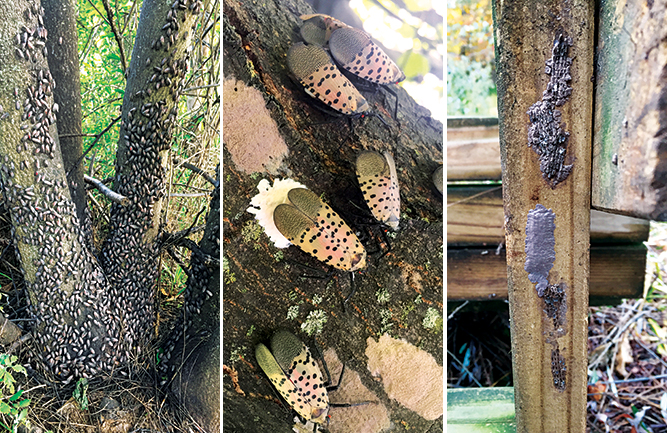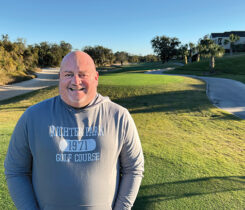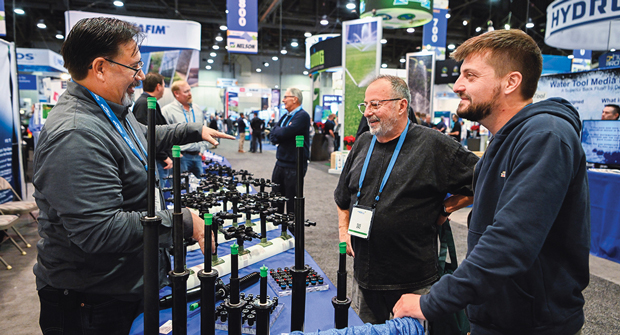Experts’ Insights: Why spotted lanternfly is a golf course hazard

The best way to stop the spotted lanternfly’s spread is to scout for egg masses, which resemble mud splatters (right). Females can lay eggs on almost any surface (center). Expect higher populations around tree of heaven (left). (Photos by: Emelie Swackhamer, Penn State Extension)
The first thing to know about the spotted lanternfly is it’s not a turf pest, but that doesn’t make it any less of a nuisance, experts say. The spotted lanternfly has been slowly spreading since its original discovery in Pennsylvania in 2014, and along the way, researchers are learning a lot more about the pest’s behavior.
Expect higher populations if the wooded areas of your courses have tree of heaven, Ailanthus altissima. The spotted lanternfly also feeds on grapevines and walnut trees. Other possible food sources include Styrax, Evodia, river birch, willow, Staghorn sumac and red and silver maple trees.
“Sometimes they’re parking lot trees,” Emelie Swackhamer, Penn State Extension horticulture educator says. “And if they’re right above where everybody’s parking their cars, it’s possible that they could lay their eggs on those cars. It only takes the female an hour or less to lay one egg mass.”
Swackhamer says a golfer could inadvertently transport and spread spotted lanternflies to a new area.
When lanternflies feed, the adults secrete a sticky substance called honeydew. This honeydew, aside from being messy, can also attract yellow jackets and other stinging insects. Sooty mold is also present in areas of large spotted lanternfly populations, and sometimes, a distinguishable smell comes along with the spotted lanternfly feeding on tree of heaven.
“This really sour smell develops, and it has to do with the microbes that are present because of all the honeydew,” she says. “It can really stink.”
While spotted lanternfly has been found in the Mid-Atlantic and some Midwestern states, Swackhamer says the first line of defense against new populations should be trapping and scouting for eggs and the pest itself. She recommends circle traps as sticky bands can catch unsuspecting wildlife. Swackhamer says superintendents can help slow the pest’s spread through trapping and communicating to members about its threat.

Chris Williamson
PBI-Gordon Corp.
Chris Williamson, Ph.D.
Midwest research scientist
Spotted lanternfly (SLF) causes serious damage including oozing sap, wilting, leaf curling and dieback in trees, vines, crops and many other plants. SLF feeds on more than 70 different species of herbaceous plants. Tree of heaven (TOH) is the preferred host. When SLF occurs in a new area, adults are most likely to be found on TOH. SLF also excretes a sugary substance called honeydew that encourages the growth of black sooty mold. This mold is harmless to people. However, it causes damage to plants. Females lay one or two egg masses on any hard, smooth surface, each containing 30–60 eggs in rows. After a few weeks, the egg mass turns a darker tan and starts to crack, resembling a splotch of mud and can be extremely camouflaged. This may include cushions on outdoor furniture and the rough bark of conifers. Several actions can be employed to exclude the pest: sticky bands around trees, biological control, destruction of egg masses and insecticides.

Don Grossman
Arborjet
Don Grosman, Ph.D.
Technology advancement manager and entomologist
SLF is a major nuisance pest, congregating on buildings and producing honeydew and sooty mold. It’s capable of killing grapevines, tree of heaven and walnut saplings. Established populations are found in Pennsylvania, Virginia, New Jersey, New York, Connecticut, Maryland, Delaware, West Virginia, Ohio and Indiana. The pest has been identified in Massachusetts, Rhode Island, Vermont and North Carolina, with bordering states on alert. Spotted lanternfly nymphs feed on a wide range of plant species, while adults prefer to feed on trees, particularly the tree of heaven, walnut, maple and birch. Adults lay 1-inch-long egg masses in the fall on nearly anything from tree trunks and rocks to vehicles and firewood. With no native predators, the SLF population has flourished. To treat for spotted lanternfly, we apply IMA-jet, a systemic micro-injectable product. In recent field trials, this treatment proved successful in eliminating the pest from the host tree and reducing honeydew, sooty mold production and egg masses.

Shannon Slevin
Quali-Pro
Shannon Slevin
Mid-Atlantic territory manager
SLF is spreading quickly through New England and Mid-Atlantic states because it’s an opportunistic traveler. Adults emerge from June to August. The pest will lay egg masses on nearly any surface, including vehicles, outdoor equipment and trees, and it can be transported outside quarantine areas. Prevention is dependent on routine scouting. Continue to monitor susceptible trees on your property, such as black walnut, birch, maple and fruit trees for egg masses, which are typically laid on the outer tree trunk 4 feet from the ground. Remove egg masses from the surface and collect them in a container filled with rubbing alcohol to kill the eggs. Adults and nymphs should be crushed. Control options for SLF include traps and using a bait plant such as the tree of heaven to attract the insect. Chemical control options include imidacloprid, bifenthrin and dinotefuran.












